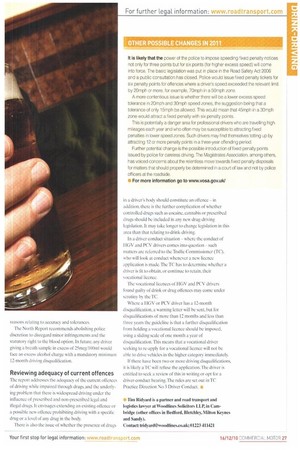Last chance saloon
Page 26

Page 27

If you've noticed an error in this article please click here to report it so we can fix it.
Drink-driving laws are likely to get tougher next year so drivers should consider abstaining before and during work shifts
Words: Tim Ridyard
This Christmas may be the last before proposed tougher penalties in drink and drug driving laws are introduced. Despite an overall reduction in death and serious injuries, drink-driving still accounts for about 430 deaths and 1,600 serious injuries a year.
The publication of the North Report Drink and Drug Driving Law earlier this year made recommendations that could become law next year. Over the next year. the current blood alcohol limit of 80mg of alcohol per 100m1 of blood could be reduced to 50ing/100m1. akin to that in many European countries,
There appears to be strong public support for this. Evidence shows serious injury or death caused by drivers impaired within the 50mg-80mg./100m1 band — that is the proposed lower limit and the permitted level. A counter argument runs that the substantial proportion of serious accidents is caused above 80mg/100m1 and the existing drink-driving limit should remain. The report does not recommend reducing the drink-drive limit to as low as 20mg/100m1. which some lobbyists have sought.
The report examined whether there should be a lower blood alcohol limit of 20mg/I0Orn1 for professional drivers of HGVs. PCVs, taxis and private-hire vehicles. The Magistrates' Association believes HG V drivers should have a lower permitted alcohol level due to the damage that can be caused by trucks involved in accidents
Aggravated offences for professionals
One industry view is that widespread alcohol testing and the threat of a driver losing employment was already a deterrent, and courts take into account whether a driver is a professional driver when passing sentence. Magistrates' Court sentencing guidelines rule that any offence by a professional driver is a potentially aggravated one and should be taken more seriously than one by a motorist.
Cutting the drink-drive limit to Sling alcohol/I 00m1 blood raises the question of whether the minimum mandatory 12-month disqualification period could be reduced at the lower end, but there are no plans to do so.
A toughening of the law is proposed for drivers who are marginally over the drink-driving limit. At the moment, drivers who give breath specimens at a police station above the legal limit but not exceeding 50rncg/100m1 (the legal breath-alcohol level being 35mcg/100m1) have the right to replace their breath specimen with blood.
Historically, this relates to the accuracy of breathsample machines but it is argued that modern devices are very accurate. A suspect who opts to provide a blood sample can enjoy a reduction in their blood/alcohol level when a police surgeon is found to take the sample.
The police generally do not prosecute a driver whose reading does not exceed 40mcg/100m1 because they are not significantly over the limit. Again, this is for historical
reasons relating to accuracy and tolerances.
The North Report recommends abolishing police discretion to disregard minor infringements and the statutory right to the blood option. In future, any driver giving a breath sample in excess of 25mcgil 00ml would face an excess alcohol charge with a mandatory minimum 12-month driving disqualification.
Reviewing adequacy of current offences
The report addresses the adequacy of the current offences of driving while impaired through drugs, and the underlying problem that there is widespread driving under the influence of prescribed and non-prescribed legal and illegal drugs. IL envisages extending an existing offence or a possible new offence prohibiting driving with a specific drug or a level of any drug in the body There is also the issue of whether the presence of drugs
in a driver's body should constitute an offence — in addition, there is the further complication of whether controlled drugs such as cocaine, cannabis or prescribed drugs should be included in any new drag-driving legislation. It may take longer 10 change legislation in this area than that relating to drink-driving.
In a driver conduct situation where the conduct of I IG V and PCV drivers comes into question such matters are referred to the Traffic Commissioner (TC), who will look at conduct whenever a new licence application is made. The TC has to determine whether a driver is fit to obtain, or continue to retain, their vocational licence.
The vocational licences of HGV and PCV drivers found guilty of drink or drug offences may come under scrutiny by the TC.
Where a 1-1GV or PCV driver has a 12-month disqualification, a warning letter will be sent, but for disqualifications of more than 12 months and less than three years the guideline is that a further disqualification from holding a vocational licence should be imposed, using a sliding scale of one month a year of disqualification. This means that a vocational driver seeking to re-apply for a vocational licence will not be able to drive vehicles in the higher category immediately.
If there have been two or more driving disqualifications, it is likely a TC will refuse the application.The driver is entitled to seek a review of this in writing or opt for a driver-conduct hearing. The rules are set out in TC Practice Direction No 3 Driver Conduct. mi
ib Tim Ridyard is a partner and road transport and logistics lawyer at Woodfines Solicitors HT, in Cambridge (other offices in Bedford, Bletchley, Milton Keynes and Sandy).
Contact: tridyard@woodfines.co.uk; 01223 411421
























































































































